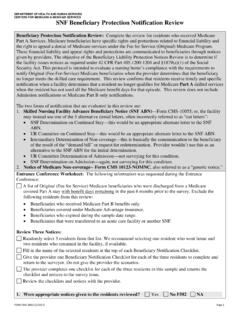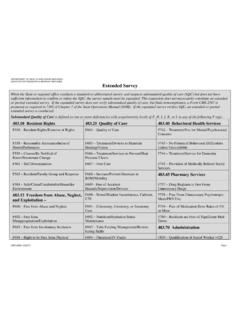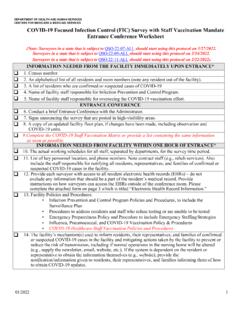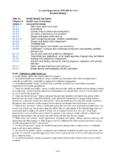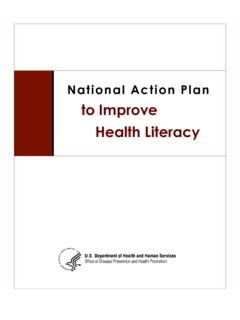Transcription of DEPARTMENT OF HEALTH AND HUMAN SERVICES …
1 DEPARTMENT OF HEALTH AND HUMAN SERVICES CENTERS FOR MEDICARE & MEDICAID SERVICES Kitchen Observation Kitchen/Food Service Observation: Complete the initial brief kitchen tour upon arrival at the facility, with observations focused on practices that might indicate potential for foodborne illness. Make additional observations throughout the survey process in order to gather all information needed. Refer to the current FDA Food Code as needed. Initial Brief Tour of the Kitchen: Review the first two CEs to ensure practices prevent foodborne illness. Potentially hazardous foods, such as beef, chicken, pork, etc., have not been left to thaw at room temperature.
2 Food items in the refrigerator(s) are labeled or dated. Potentially hazardous foods such as uncooked meat, poultry, fish, and eggs are stored separately from other foods ( , meat is thawing so that juices are not dripping on other foods). Hand washing facilities with soap and water are separate from those used for food preparation. Staff are practicing appropriate hand hygiene and glove use when necessary during food preparation activities, such as between handling raw meat and other foods, to prevent cross-contamination. Cracked or unpasteurized eggs are not used in foods that are not fully cooked (per observation or interview). Food is prepared, cooked, or stored under appropriate temperatures and with safe food handling techniques. Staff are employing hygienic practices ( , not touching hair or face without hand washing) and then handling food.
3 1. During the initial brief tour, are foods stored and/or prepared under sanitary conditions? Yes No F812 2. During the initial brief tour, does the facility handle, prepare, and distribute food in a manner that prevents foodborne illness to the residents? Yes No F880 Follow Up Visits to the Kitchen: If staff are preparing food during the initial brief tour, proceed with observations. If not, answer the remaining items in future trips to the kitchen. Storage Temperatures Refrigerator temperatures that are at or below 41 degrees Fahrenheit ( F) (check temperatures between meal service activities to allow for stable temperatures). Freezer temperatures maintained at a level to keep frozen food solid. Internal temperatures of 41 F or lower for potentially hazardous, refrigerated foods ( , meat, fish, milk, egg, poultry dishes) that are not within acceptable ranges: What are the temperatures?
4 What foods are involved? FORM CMS 20055 (5/2017) Page 1 DEPARTMENT OF HEALTH AND HUMAN SERVICES CENTERS FOR MEDICARE & MEDICAID SERVICES Kitchen/Food Service Observation 3. Is the food stored at the appropriate temperatures? Yes No F812 Food Storage Frozen foods are thawing at the correct temperature. Foods in the refrigerator/freezer are covered, dated, and shelved to allow circulation. Foods are stored away from soiled surfaces or rust. Canned goods have an uncompromised seal ( , punctures). Staff are only using clean utensils when accessing bulk foods and/or ice. Containers of food are stored off the floor, on surfaces that are clean or protected from contamination ( , 6 inches above the floor, protected from splash).
5 There are no signs of water damage from sewage lines and/or pipelines. There are no signs of negative outcome ( , freezer burn, foods dried out, foods with a change in color). Raw meat is stored so that juices are not dripping onto other foods. Food products are discarded on or before the expiration date. Staff are following the facility s policy for food storage, including leftovers. 4. During follow-up visits to the kitchen, are foods stored under sanitary conditions? Yes No F812 Food Preparation and Service Hot foods are held at 135 F or higher on the steam table. Cold foods are held at 41 F or lower. Food surfaces are thoroughly cleaned and sanitized after preparation of fish, meat, or poultry. Cutting surfaces are sanitized between uses.
6 Equipment ( , food grinders, choppers, slicers, and mixers) are cleaned, sanitized, dried, and reassembled after each use. If staff is preparing resident requests for soft cooked and undercooked eggs ( , sunny side up, soft scrambled, soft boiled), determine if a pasteurized egg product was used. Proper final internal cooking temperatures (monitoring the food s internal temperature for 15 seconds determines when microorganisms can no longer survive and food is safe for consumption). Foods should reach the following internal temperatures: Poultry and stuffed foods: 165 F; Ground meat ( , ground beef, ground pork, ground fish) and eggs held for service: at least 155 F; FORM CMS 20055 (5/2017) Page 2 DEPARTMENT OF HEALTH AND HUMAN SERVICES CENTERS FOR MEDICARE & MEDICAID SERVICES Kitchen/Food Service Observation Fish and other meats: 145 F for 15 seconds.
7 When cooking raw animal foods in the microwave, foods should be rotated and stirred during the cooking process so that all parts of the food are heated to a temperature of at least 165 F, and allowed to stand covered for at least 2 minutes after cooking to obtain temperature equilibrium; and Fresh, frozen, or canned fruits and vegetables: cooked to a hot holding temperature of 135 F to prevent the growth of pathogenic bacteria that may be present. Food items that are reheated to the proper temperatures: The potentially hazardous food (PHF) or time/temperature controlled for safety (TCS) food that is cooked and cooled must be reheated so that all parts of the food reach an internal temperature of 165 F for at least 15 seconds before holding for hot service; and Ready- to-eat foods that require heating before consumption are best taken directly from a sealed container (secured against the entry of microorganisms) or an intact package from an approved food processing source and heated to at least 135 F for holding for hot service.
8 Food is covered during transportation and distribution to residents. Food is cooked in a manner to conserve nutritive value, flavor, appearance, and texture. Nourishments and snacks that are held at room temperature are served within 4 hours of delivery. Potentially hazardous foods ( , milk, milk products, eggs) must be held at appropriate temperatures. Staff properly wash hands with soap and water to prevent cross-contamination ( , between handling raw meat and other foods). Staff utilize hygienic practices ( , not touching hair, face, nose, etc.) when handling food. Staff wash hands before serving food to residents after collecting soiled plates and food waste. Opened containers of potentially hazardous foods or leftovers are dated or used within 7 days in the refrigerator or according to facility policy.
9 Proper cooling procedures were observed, such as cooling foods in shallow containers, and not deep or sealed containers, facilitating foods to cool quickly as required. Potentially hazardous foods are cooled from 135 F to 70 F within 2 hours; from 70 F to 41 F within 4 hours; the total time for cooling from 135 F to 41 F should not exceed six hours. Food procured from vendors meets federal, state, or local approval. Review the policies and procedures for maintaining nursing home gardens, if applicable. The time food is put on the steam table and when meal service starts. If unable to observe, determine per interview with the cook. How staff routinely monitors food temperatures on the steam table (review temperature logs). When staff starts cooking the food.
10 If unable to observe, determine per interview with the cook. What cooking methods are available and used ( , steamer, batch-style cooking). Ensure staff do not compromise food safety when preparing modified consistency ( , pureed, mechanical soft) PHF/TCS foods. Ask staff about their knowledge of the food safety practice and facility policy around the particular concern identified. Does the facility have written policies ( , eggs) that honor resident preferences safely? FORM CMS 20055 (5/2017) Page 3 DEPARTMENT OF HEALTH AND HUMAN SERVICES CENTERS FOR MEDICARE & MEDICAID SERVICES Kitchen/Food Service Observation Does the facility have a written policy regarding food brought in by family or visitors?

